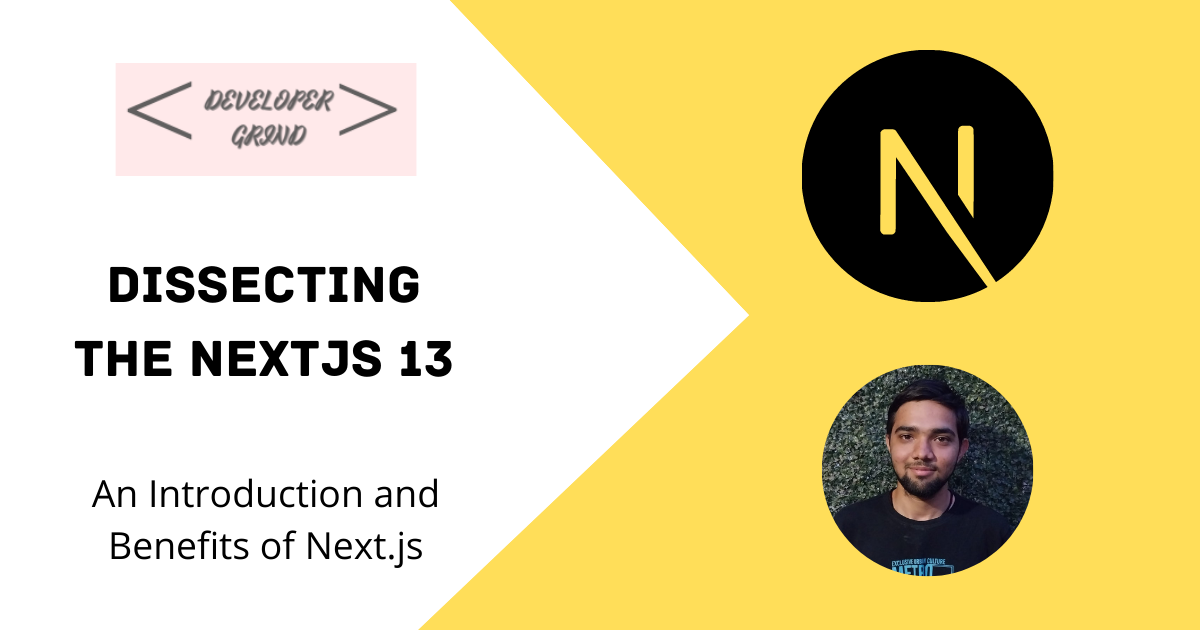Next.js - Starting a new series
 Devrajsinh Jhala
Devrajsinh Jhala
Hello everyone, welcome to the new series where we will be learning the ins and outs of Next.js 13 so that you can build apps that leverage some of the best concepts such as Server Side Rendering and can deliver web apps with better user experience.
We will be starting from the basics such as file and folder structure, Routing, etc. and then move to advanced topics such as Server Side Rendering, Static Site Generation. As always, I believe in Learning by building and hence I will be teaching you theory along with lots and lots of practical examples as well. In this Blog, we will be exploring introductory topics like What is Next.js, Why you should learn Next.js, and What are the advantages and outline of this series.
What is Next.js?
First, let me explain to you in simple terms, Next.js is a framework built by Vercel on top of React which provides additional features such as better SEO, better API Management, better Developer Experience, and better User Experience.
Let's look at the official Next.js documentation to understand it in more depth. According to the documentation:
Next.js is a React framework that gives you building blocks to create web applications. By framework we mean Next.js handles the tooling and configuration needed for React and provides additional structure, features, and optimizations for your applications.
Why Next.js when you have learnt React?
You have worked hard to learn React and now you have to learn Next.js!! You might be wondering what is the use case of this. Here are some of the benefits you get by learning the Next.js framework:
Better SEO:
- Next.js's SSR and SSG capabilities make it highly SEO-friendly. Search engines can easily crawl and index the content of your application, improving its visibility in search results. By learning Next.js, you'll learn how to build web applications that are optimized for search engine rankings.
Better Developer Experience:
- Next.js offers a great developer experience, with features like hot module replacement (HMR) for instant code changes, robust error handling, and compatibility with popular development tools and IDEs.
File-Based Routing:
- Next.js uses file-based routing (Next.js 12) and folder-based routing (Next.js 13) out-of-the-box while in React, you have to install and configure routing via React Router Dom.
Better API Management:
- Next.js allows developers to create serverless API endpoints within the application. These API routes can handle server-side logic and interact with databases or external APIs, all within the same codebase. React alone does not have built-in support for serverless APIs, so Next.js
Advantages of Next.js:
Next.js offers several advantages for web development:
Improved performance: Next.js optimizes the performance of web applications through server-side rendering, static site generation, and automatic code splitting. This results in faster page loads, improved SEO, and a better user experience.
Simplified development: Next.js provides a streamlined development experience with features like built-in routing, CSS and styling support, and automatic transpilation and bundling. It abstracts away much of the complex configuration and setup, allowing developers to focus on building features.
Server-side rendering and static site generation: Next.js supports server-side rendering and static site generation out of the box. This enables faster initial page loads, better SEO, and the ability to serve static files directly from a CDN. It also allows for dynamic updates and real-time data fetching on the client side.
Hybrid rendering: Next.js supports a hybrid approach where certain pages can be statically generated while others can be server-rendered or client-rendered. This flexibility allows developers to choose the most suitable rendering method based on the specific requirements of each page.
API routes: Next.js makes it easy to create serverless API endpoints within your application. This enables developers to handle server-side logic and interact with databases or external APIs directly from the application. It eliminates the need for separate backend infrastructure for simple API functionality.
Great developer experience: Next.js offers a great developer experience with features like hot module replacement (HMR), which allows for instant code changes and updates without full-page refreshes. It also provides a rich set of development tools and integration with popular IDEs and editors.
Strong ecosystem and community support: Next.js has a vibrant ecosystem and a large community of developers actively contributing to its growth. This results in a wide range of plugins, extensions, and community-created packages that can enhance the capabilities of your Next.js applications.
SEO-friendly: Next.js's server-side rendering and static site generation capabilities make it highly SEO-friendly. Search engines can easily crawl and index the content of your application, improving its visibility in search results.
Incremental adoption: Next.js allows for incremental adoption, meaning you can start using it in existing projects or introduce it gradually to specific pages or sections of your application. This flexibility makes it easier to migrate or adopt Next.js in existing codebases.
Outline of this series:
Next.js Folder-based file notations
Next.js File and Folder Structure
Next.js Routing, Data Fetching, Dynamic Routes and Metadata
Server Side Rendering (SSR), Static Side Generation (SSG) and Incremental Server Regeneration (ISR)
Pre-requisites:
Although this course is beginner friendly I expect you to have a good understanding of concepts related to JavaScript and React because as we have seen above, Next.js is built on top of React. It's good to have some knowledge of Tailwind CSS and even if you don't it's fine because we are not learning CSS. You can watch my series on Tailwind CSS as well for a better understanding. Before starting this series, please read a bit about React Server Components as well.
So with all these things in mind, it's better to learn Next.js or at least understand its concepts so that you can have an edge in building wonderful apps. So let's go and learn some new things🚀.
Subscribe to my newsletter
Read articles from Devrajsinh Jhala directly inside your inbox. Subscribe to the newsletter, and don't miss out.
Written by

Devrajsinh Jhala
Devrajsinh Jhala
Self-taught Developer with over 2 years of experience in developing websites. I want to help clients build websites with technologies like 𝗥𝗲𝗮𝗰𝘁.𝗷𝘀, 𝗡𝗲𝘅𝘁.𝗷𝘀, 𝗮𝗻𝗱 𝗧𝗮𝗶𝗹𝘄𝗶𝗻𝗱𝗖𝗦𝗦 to make their websites fast, and UX-friendly. I also love teaching the things I learn, so I also blog my learnings in a way for people with little knowledge to consume. Web-Developer: Made over 𝟱+ 𝗽𝗿𝗼𝗷𝗲𝗰𝘁𝘀 on web development with a range of technologies including Reactjs, Nextjs, TailwindCSS, Bootstrap, Redux, ContextAPI, etc. I believe in Learning by building and so I love applying what I learned to help clients build premium websites with the latest technologies to give their end-users the best experience possible. Additionally, I also love watching anime and playing online video games. Feel free to connect with me: Email: jhaladevrajsinh11@gmail.com